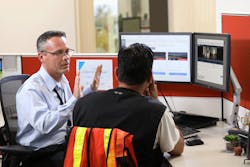“Video can help reveal operational issues better than pure data.”
So says Del Lisk, VP safety services for Lytx, a provider of video solutions that use artificial intelligence and machine vision to detect unsafe driving habits. Lytx links video with machine data from a vehicle’s GPS, accelerometer, and on-board computers to provide equipment managers with telematics insights that fuel coaching opportunities. Coaching improves behavior to such a degree, Lisk says, that fleets will probably see insurance premiums drop over time.
Other articles about how to use telematics operator and driver coaching:
“We typically see [an initial] 50 to 80 percent reduction in claims costs on average,” he says, which are the costs of bent metal, injuries, and other claims paid out for an incident. “It won’t drop my premium next year, but if I accomplish that 50-percent reduction and I keep it down—or even drive it down further—by the time that policy expires, on the next renewal, I’m going to get a much lower rate.
“The asterisk I’d put there is, as long as they do the program correctly,” Lisk says.
The program means coaching, both self-coaching and supervisor-directed coaching.
“Our first focus would be [fleet managers] taking the steps to prepare their drivers to coach themselves,” he says. “Just sticking this technology in and having it beeping and saying, ‘distracted, distracted,’ without some effective management communication isn’t enough. The first level of coach is the driver themselves.”
Lytx uses cameras mounted in and around the vehicle that have multiple sensors and are powered by machine vision and artificial intelligence to capture potentially risky behavior, analyze it, and report to both the driver or operator and the company representatives who manage that behavior.
“[Previously], we would capture video on an exception basis. [If] a vehicle experienced a sudden change in force—that would be hard braking, a sudden swerve, a collision—it would capture a short exception-based video that we would then analyze. Or it could determine if a vehicle was going either beyond the company’s mandated maximum permitted speed limit, or if they were going over the posted speed limit.”
Machine vision can identify stop signs, lane markers, vehicles around the subject vehicle, among others. Lytx’s dash cams capture machine data such as speed, the real-time video, and its database of captured video to train its artificial intelligence.
“We’ve analyzed literally billions of miles of video,” Lisk says. “On a simpler level, [AI] can recognize a stop sign, and it can then look at speed. In our case, if the speed doesn’t go below 3 miles an hour as it crosses that stop sign, it’s going to flag it and capture video of an incident where the driver ran a stop sign.”
The AI provides another layer of identifying risky behavior, such as driver fatigue or distracted driving.
“The technology is trained to recognize if the driver is holding a cellphone in their hand,” Lisk says. “It can be configured to capture that video; it can also be configured to simply send the driver an alert. If they don’t put the phone down, it will then capture video.
“[This] shifts the coaching from management—which has trouble having the time to do it—to the driver. It’s their opportunity first to self-correct that behavior. [We are] first empowering them through alerts to give them the opportunity to correct their behavior, and then if they aren’t correcting the behavior, capturing the video that may be...used by management to observe and coach the driver.”
The AI becomes the coach, and it helps identify the smaller number of drivers or operators that need “targeted, escalated” coaching, Lisk says.
“This is a generalization, but the construction industry is so ‘pedal to the metal’ that the idea of hooking up with someone who had poor driving behavior that didn’t result in [a collision]…ends up last on the list for the local field supervisor to address. If you had 20 people you need to coach, but 17 could self-correct, that sure makes the day more efficient.”
Although telematics collect data on hard braking instances, for example, Lisk says having a conversation around a report can be “pretty challenging.”
"But if I instead share a video with you, where you were looking at paperwork for several seconds going down the road, and then at the very last moment looked up and swerved to avoid a bike rider, that’s a much more powerful and effective way of communicating and changing behavior," he says.
Lisk defines coaching as sitting with a person, listening, understanding, collecting information, bouncing ideas off the person, and guiding them to come to the decisions about what they need to do differently.
“The beauty of video—to a significant degree—is that sometimes the mistake, the error is so evident that you can...say, ‘Let me share this video with you. Why don’t you fill me on what was going on.’ The video facilitates that conversation, and a big part of coaching is conversing.”
The end result of effective coaching, enhanced by machine vision- and AI-triggered video, is overall improvements in safety and costs.
“If an operator is driving safely, they will get there when they’re expected, and they’re not going to have ancillary cost and time [losses] if they make mistakes,” Lisk says.
This video technology has become mainstream, Lisk says, so much so that in litigation attorneys are increasingly asking for video evidence.
“At the end of the day, it will improve driving behavior, it will make people safer, it will protect company employees as well as the general public better,” Lisk says.
About the Author
Rod Sutton
Sutton served as the editorial lead of Construction Equipment from 2001 through 2025.
